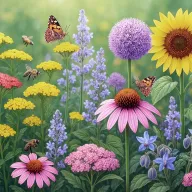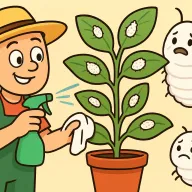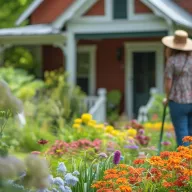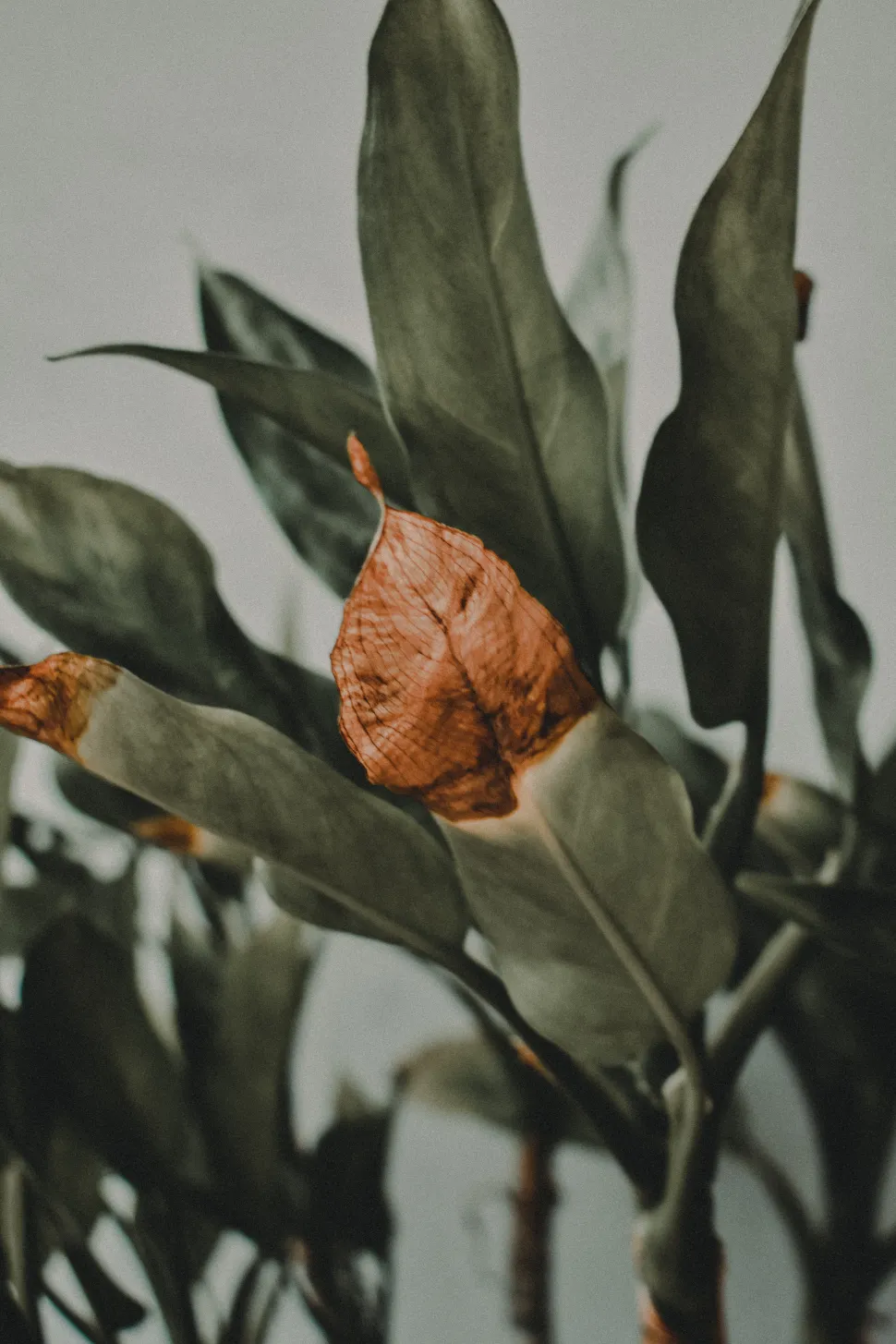
Why do the leaves on my plant have brown tips?
Article for :Beginner and plant killerExperienced plant lover
50 shades of white. A cameo of green. A pink gradient. While we love to see color on the foliage of our houseplants, there's one color we dread: brown. Especially when it appears at the end of the leaf blades. Are the tips of your plant's leaves turning brown? We'll tell you why, and what you can do about it.
Your plant lacks water
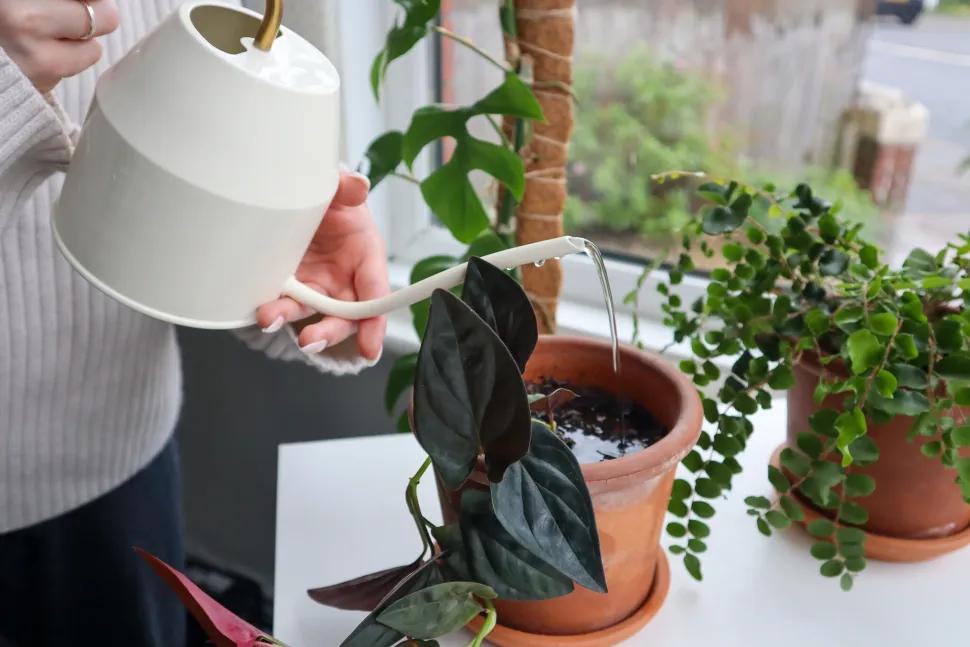
When watering, soak the entire substrate. This helps root development. Photo by Dan Jones / Flickr
Inadequate watering can cause leaf tips to turn brown. When your plant doesn't get enough water, it can't feed all the foliage. The sap doesn't reach the tips of the leaf blades, which turn brown.
Can't remember the last time you took out your watering can? You may have found the cause of those unsightly limbs. Touch the rootball to be sure. If the soil is slightly moist, all is well. But if it's rock-hard, you know why your leaves are turning brown.
Watering can be insufficient for two reasons. The first is frequency: you're not watering often enough. The second is quantity: you're not giving your plant enough water. Some gardeners are afraid of overdoing it. They simply moisten the surface of the soil. But for most plants, this is not enough. It's better to water copiously, until the water escapes from the drainage holes. Then leave your plant to drain for ten to fifteen minutes. If you're using a dish or planter, remove any water that stagnates in the saucer. It will rot the roots.
You water generously and regularly, but the substrate dries out in one or two days? The pot is probably too small for your plant. Re-pot to give the roots more room and increase the volume of water at each watering.
You've over-watered
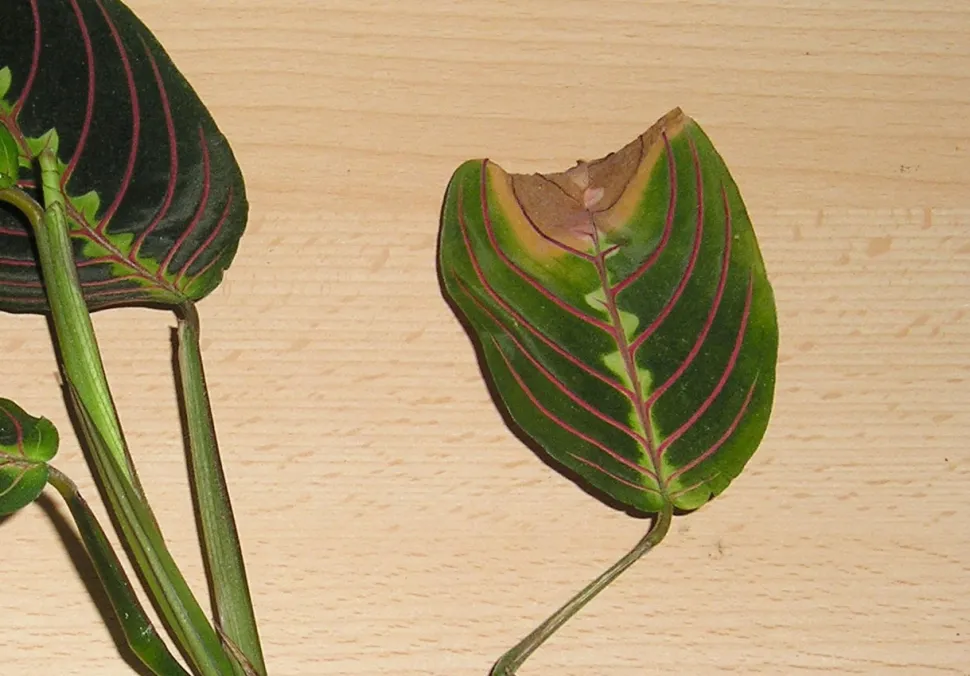
A leaf with a dried tip can be a sign of root rot. Photo by Maja Dumat / Flickr
But leaf tips can also turn brown from overwatering. We're not talking about quantity here, but frequency. When you water your plant too often, the soil doesn't have time to dry out. It becomes waterlogged and no longer contains enough oxygen. The leaf blades turn brown. And it starts with the tips. If you don't take action, the whole plant turns black and dies.
Leaf color isn't the only sign of an over-watered plant. The unfortunate ones usually bathe in soggy soil. Their leaf blades are not only yellow or brown. They're also soft and drooping.
Watering your Euphorbia lactea 'White Ghost every day? Don't! Even in summer, most varieties require no more than one or two waterings a week. Always touch the soil before drawing on your watering can. If the soil is still moist, chances are your plant isn't thirsty.
Saving a victim of overwatering isn't easy. But it's not impossible. The first thing to do is to stop watering and dry out the root ball. You can move your plant to a sunnier spot to speed up the process. If the situation is critical, don't hesitate to repot. Even in winter. After removing the root ball, remove the old substrate. Cut off any rotten roots (which can be recognized by their brown color) with clean pruning shears. Then plant in a pierced pot with a drainage layer and suitable potting soil.
Your plant is too hot
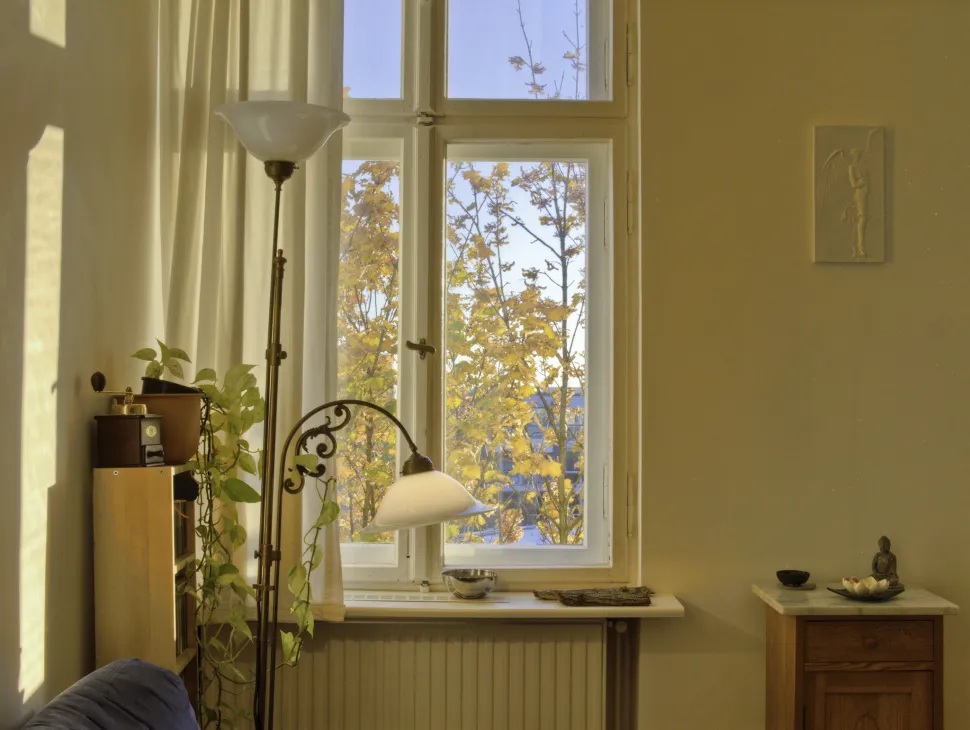
Even if your plant is overheated, don't put it next to a radiator. Photo by Sascha Kohlmann / Flickr
Plants sweat more when they're hot. If they don't have enough water in reserve, they can't feed the tips of their leaves. Just as when watering is too low, the tips will turn brown. Other signs, such as wilting leaf blades and falling flower buds, indicate a temperature that's too high.
In theory, most specimens sold as green plants can withstand the temperature of our homes. But some retailers sell species in the houseplant section, such as dionaea muscipula Dionée attrape-mouche, that need to be grown outside, in the garden or on a terrace. Other varieties need lower winter temperatures to continue growing. Before bringing a plant home, check its growing conditions. This information is just a few clicks away on the Monstera website and app.
Even when they're suitable for indoor cultivation, potted plants can get hot under the collar. This is the case in summer, during heatwaves, and in winter, when radiators are set to maximum. To prevent your Dwarf fig from drying out and turning brown, keep it away from convector heaters. And don't leave it behind the window when the thermometer's going crazy.
Your indoor air is too dry
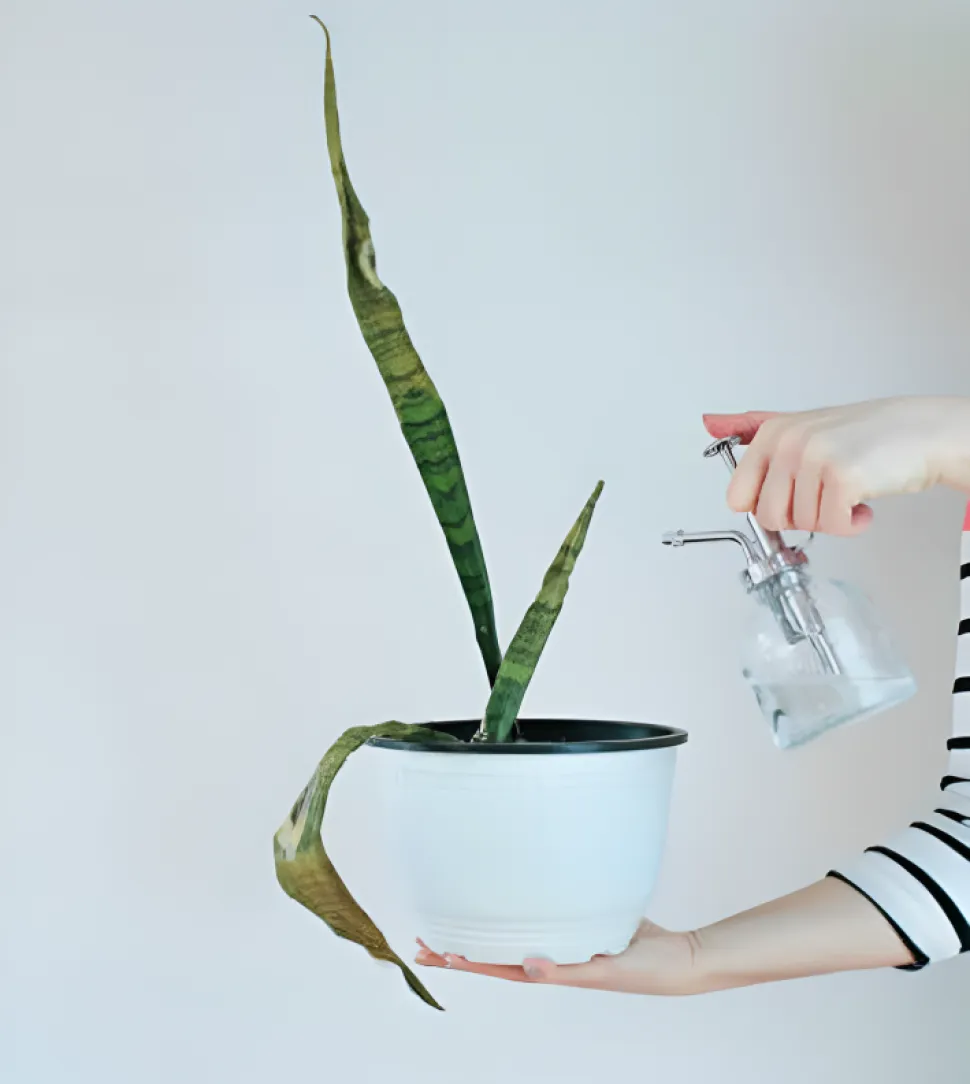
Misting is not very effective, especially on succulents. Photo by Danica Jacovjevic
Most of the plants we grow indoors are tropical varieties, originating from regions where humidity levels exceed 70%. In our homes, humidity levels tend to be between 40% and 60%. To compensate for this dry environment, plants sweat more. But this expenditure is not without consequences: they no longer have enough water to irrigate the tips of their leaf blades. Leaves begin to turn brown.
The best way to find out if the air in your home is too dry is touse a hygrometer. Measure humidity in different places. Some rooms, like bedrooms, are less humid than bathrooms and kitchens. But not many of us own a hygrometer. If you don't want to invest, look for other signs of a very dry interior, such as high levels of dust or statistical electricity. If you're always thirsty at night, if your eyes itch and your lips are chapped, it's sometimes because the atmosphere is too dry.
There are several ways toincrease indoor humidity and prevent browning of limbs and tips. The first is to buy a humidifier. It improves humidity levels for plants placed close together, or even in the same room. You can also group your plants together. In this way, some plants benefit from the transpiration of others, just as in nature. Another well-known trick is to place pots on a dish of moist clay balls. Finally, there's nothing to stop you misting your plants. Fogging has only a very temporary effect, but it does help combat red spiders and other pests that proliferate when the air dries out. Always use non-calcareous water, to avoid leaving marks on the foliage.
Unsuitable exposure
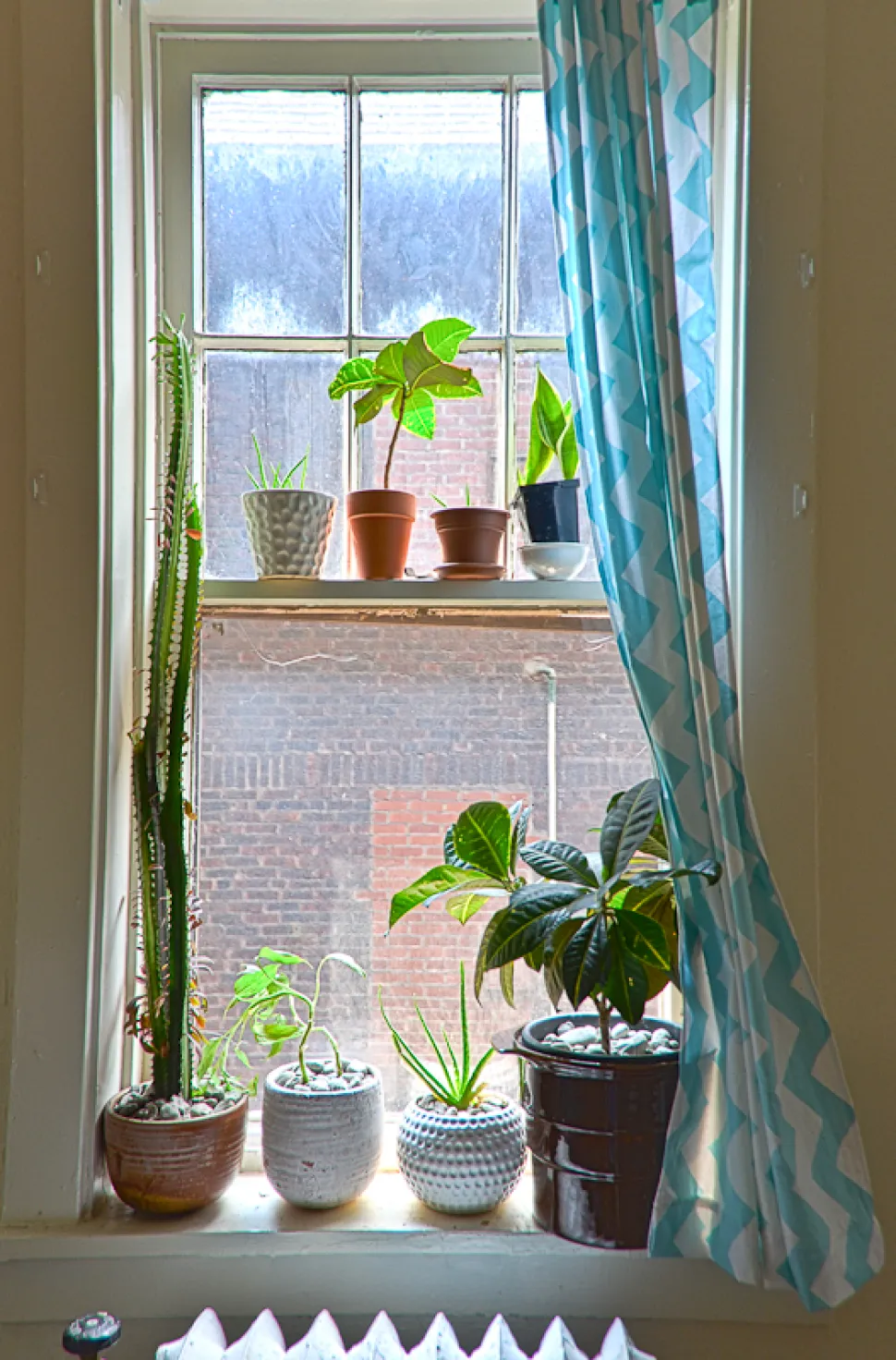
Too much light can turn the tips of your leaves brown. Photo by Sk / Flickr
Brown tips can be the result of exposure to too much sunlight. This is especially true in summer, when the sun's rays are strongest. They can burn the foliage and cause brown spots on the leaves.
But the problem also arises the rest of the year, if you don't keep to the recommended light levels. Plants need natural light to thrive. However, not all require the same intensity. Ferns, Calathea and Aglaonema, for example, prefer a spot in semi-shade to one behind a window, even if it's screened by a curtain.
You've given your houseplant too much fertilizer
Are your plant's leaves turning brown immediately after fertilizing? The culprit is obvious: over-fertilization.
Over-fertilization can occur when you fertilize too often, or when you administer too large a dose. The soil is overloaded with mineral salts, which rise in the leaves. The plant is drained of water and the tips of the leaf blades, which are no longer irrigated, turn brown.
To correct your mistake, rinse the substrate. Take your plants out into the rain and let the downpour wash away the soil. As the water runs off through the drainage holes, it takes the excess nutrients with it. If it doesn't rain, water generously with non-calcareous water, preferably at room temperature.
Once the soil has dried, resume your watering and fertilizing routine. But stick to the quantities prescribed by the manufacturer!
You've watered with tap water
Tap water is not the best solution for watering your plants. Photo by Kaboompics / Rawpixels
In nature, plants benefit from rain. In the garden and indoors, however, we tend to water with tap water. This water contains chlorine, mineral salts and other elements that are harmful to our protected plants. They are stored in the soil and end up poisoning the plant. The effects can first be seen at the tips of the leaves, which turn brown.
To prevent this phenomenon, use rainwater as a priority. If you can't get any, invest in demineralized water. Have no choice but to water your plants with mains water? Wash the substrate once or twice a year and repot regularly to avoid the concentration of chlorine and other undesirable substances.
Which species are most at risk of browning leaf tips?
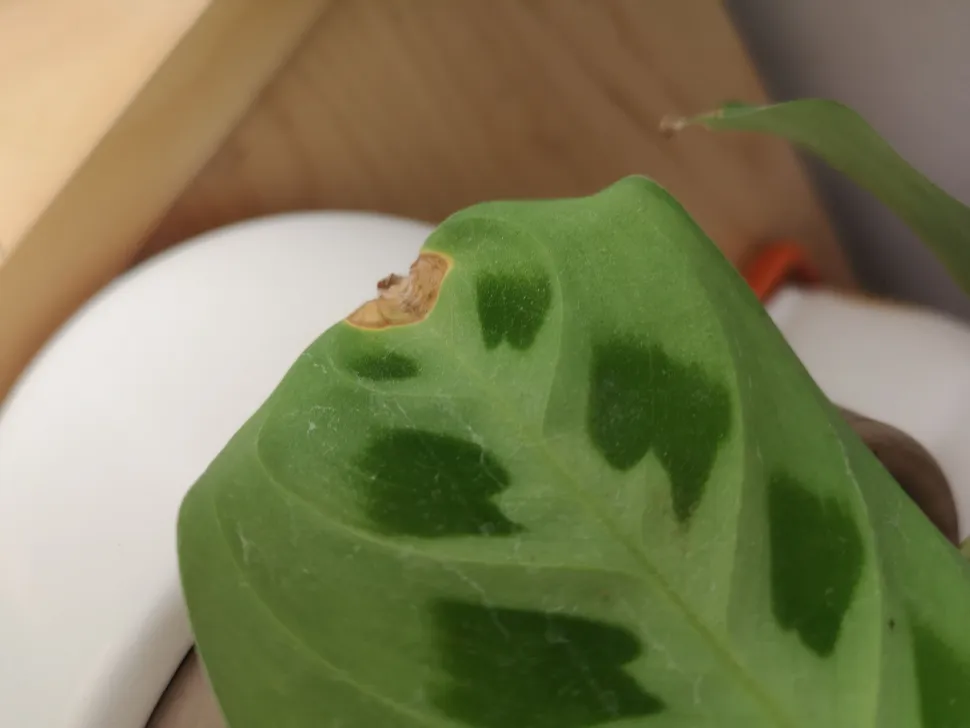
The leaf tips of my Marantaceae always end up drying out in winter.
Are you a perfectionist who can't stand to see your plants turn brown, even by a few millimeters? Give up on Marantaceae. In pots, Calathea, Maranta and Ctenanthe are the champions of the brown tip. These tropical species do not adapt well to our dry interiors. Even with a humidifier or in a shower room.
Forget, too, varieties with long, tapering leaves, such as fragrant Dragonwood 'Lemon lime, yucca aloifolia and saw Palmetto. The plant has trouble getting the sap to the tips of the leaf blades. The tips almost always turn brown.
Choose succulent or semi-succulent plants such as echeveria elegans, chinese coin plant or haworthiopsis attenuata. They don't mind dry air, over-watering or forgetting!
Should I cut off leaf tips when they've turned brown?
Once a leaf tip has turned brown, there's no turning back. Despite your best care, your plant will never become completely green again.
If that brown spot at the tip is keeping you awake at night, you can remove it. Cut off the tip of the leaf blade with pruning shears or scissors. Remember to clean your instrument thoroughly before and afterwards. This way, you can be sure not to spread disease.
Only remove the brown tip. Resist the temptation to remove the whole leaf. The rest of the leaf blade, still green, contributes to photosynthesis and is useful to the plant.
By Servane Nemetz
on 03-11-2023 at 08h21
on 03-11-2023 at 08h21


